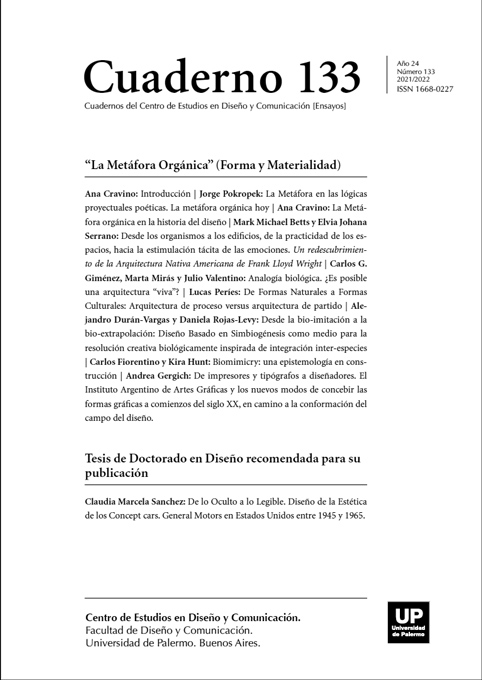Desde la bio-imitación a la bioextrapolación: Diseño Basado en Simbiogénesis como medio para la resolución creativa biológicamente inspirada
Abstract
The origin of ideas depends in many cases on the analogue capacity assumed by the designer to extrapolate the qualities from the source of inspiration. When this inspiration comes from the natural, we recognize it as Biologically Inspired Design. This article presents a summary of these approaches, together with the potential of Design Based on Symbiogenesis as a model that, in addition to recognizing the value of biological analogy, incorporates evolutionary dynamics associated with the origin of species through cooperation and integration through symbiosis.
References
Boden, M. A. (1996). Creativity. In Artificial intelligence (pp. 267-291). Academic Press.
Camere, S. & Karana, E. (2018). Fabricating materials from living organisms: An emerging design practice. Journal of Cleaner Production, 186, 570-584.
Cordua, C. (1996). Wittgenstein: análogos del lenguaje. Areté, 8(2), 191-213.
de Bary, A. (1879). Die erscheinung der symbiose. Verlag von Karl J. Trubner, Strassburg.
Dumas, J. S. & Redish, J. (1999). A practical guide to usability testing. Intellect books.
Durán, A. & O’Ryan, L. (2019). Symbiogenesis-Based Design: a novel methodological approach to design based on cooperation and integration. The Design After, Cumulus Conference Proceedings Series Bogota 2019, 554-567.
Fayemi, P. E.; Maranzana, N.; Aoussat, A. & Bersano, G., “Bio-inspired design characterisation and its links with problem solving tools,” Proc. Int. Des. Conf. Des. 2014-Janua, D. Marjanović; M. Štorga; N. Pavković, and N. Bojčetić, Eds., 173-182, The Design Society,
Glasgow, UK. (2014). Fujii, H.; Yoshida, K. & Sugimura, K. (2016). Research and development strategy in biological technologies: A patent data analysis of Japanese manufacturing firms. Sustainability, 8(4), 351. Helms, M.; Vattam, S. S. & Goel, A. K., “Biologically inspired design: process and products,” Des. Stud. 30(5), 606-622 (2009).
ISO 18458 (2015). “Biomimetics-Terminology, Concepts and Methodology,” ISO 2015. Lenau, T. A.; Metze, A. L. & Hesselberg, T. (2018). Paradigms for biologically inspired design. In Bioinspiration, Biomimetics, and Bioreplication VIII (Vol. 10593, p. 1059302). International Society for Optics and Photonics.
Margulis, L. & Fester, R. (Eds.). (1991). Symbiosis as a source of evolutionary innovation: speciation and morphogenesis. Mit Press.
Margulis, L. & Sagan, D. (2008). Acquiring genomes: A theory of the origin of species. Basic books.
Margulis, L. and Dorion, S. (1998). Microcosmos: Four Billion Years of Evolution from Our Microbial Ancestors. University of California Press.
Mironov, V.; Trusk, T.; Kasyanov, V.; Little, S.; Swaja, R. & Markwald, R. (2009). Biofabrication: a 21st century manufacturing paradigm. Biofabrication, 1(2), 022001.
Risbud, A. S. & Bartl, M. H. (2013). Engineered Biomimicry: Chapter 14. Solution-Based Techniques for Biomimetics and Bioreplication. Elsevier Inc. Chapters.
Rojas, D. and Durán, A.(2017). Shelley: Soft-robot sintético-natural acuático, energéticamente sustentable; oxigenador por movimiento y purificador por plantas. Tesis presentada a Escuela de Diseño UC.
Shu, L. H.; Ueda, K.; Chiu, I. & Cheong, H. (2011). Biologically inspired design. CIRP Annals, 60(2), 673-693.
Vandevenne, D.; Verhaegen, P. A.; Dewulf, S. & Duflou, J. R. (2011). A scalable approach for the integration of large knowledge repositories in the biologically-inspired design process. In DS 68-6: Proceedings of the 18th International Conference on Engineering Design (ICED 11), Impacting Society through Engineering Design, Vol. 6: Design Information and Knowledge, Lyngby/Copenhagen, Denmark, 15.-19.08. 2011 (pp. 210-219).
Los autores/as que publiquen en esta revista ceden los derechos de autor y de publicación a "Cuadernos del Centro de Estudios de Diseño y Comunicación", Aceptando el registro de su trabajo bajo una licencia de atribución de Creative Commons, que permite a terceros utilizar lo publicado siempre que de el crédito pertinente a los autores y a esta revista.


